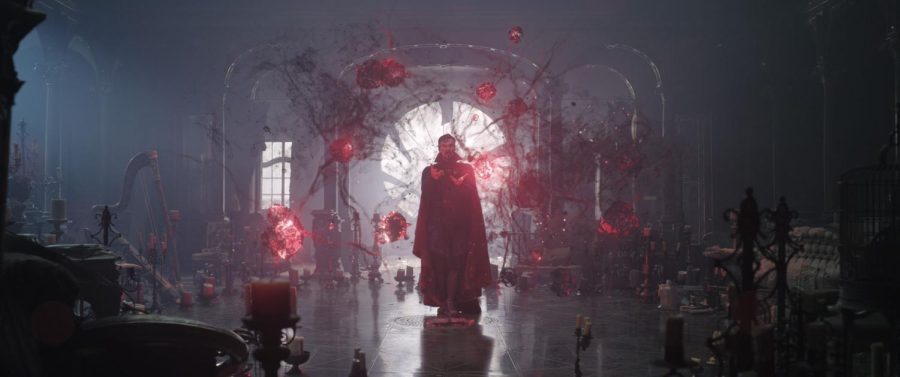Strange, stranger, and strangest
Latest Marvel film explores new genre and new tone
Dr. Strange views the multiverse. “Dr. Strange in the Multiverse of Madness” uses new themes and techniques to create a unique experience unlike any Marvel movie before. Director Sam Rami used horror techniques and his own personal style to create a movie that feels scary and heartfelt at the same time.
Warning: This review contains spoilers for “Dr. Strange in the Multiverse of Madness”
Marvel Studios is well-known for its “happy-go-lucky” tone, quippy banter mid-fight, and action genre, but the latest film “Dr. Strange in the Multiverse of Madness” sets the tone for a new age of films. From the dark themes, gore and violence, and its horror genre, this movie sets the bar for future projects to come.
The tones and themes of “Multiverse of Madness” were some of the best parts of the movie. The biggest overarching themes were portrayed well by every cast member, but the real stars were Wanda Maximoff, played by Elizabeth Olsen, and America Chavez, played by Xochitl Gomez. These two characters played off of the others well and were the true heart of the film.
One thing that created a unique stylistic element in this film is its direct relationship to the television show “WandaVision.” In the post-credits scene of “WandaVision,” the audience sees Wanda Maximoff practicing dark magic with the Darkhold, a book of all evil magic. So it felt like this movie picked up right where her story left off. That is why Maximoff as the villain of the film made a lot of sense to fans.
Her motivation throughout the film to kill America Chavez and get back to her children seems like a reasonable jump from her heartbreaking grief in “WandaVision.” What makes Wanda’s story so interesting in this film though is her growth.
The audience watches her grow through all the stages of grief, denial, anger, bargaining, depression, and acceptance, as she finally sees the truth in her actions. Olsen delivers an amazing performance that makes fans sympathize with her and enjoy her acts of villainy.
America Chavez is a multiverse hopping kid with the innate ability to attract trouble with every Dr. Strange she meets. The movie opens with her and the “Defender Strange” trying to reach the magical book that holds the answer to their problems. The whole movie America is striving to get this book, but when it is destroyed in front of her, and she has hit rock bottom, she finally unlocks the thing the book said could defeat Wanda, herself.
America’s discovery of self through her real reactions and grief for her mothers is a true pleasure to watch on screen. One of her most impactful scenes is watching her relive their deaths while Strange watches her memories alongside of her through a high tech device. The audience roots for her, and sympathizes with her struggle with the guilt of her mothers.
Both of these two characters showcase the theme that I feel is the most prevalent throughout the movie. They both highlight the fact that superheroes are not happy, they do not get what they most desire. Stephen Strange wants to be with Christine, that does not happen. Wanda wants a happy ending with her children, that is not possible. America wants to grow up with her parents, not possible. But by the end of the movie, these characters have found that they have to live with the grief for the people they cannot have. Being alone is the life of a hero.
While the thematic ideas were beautiful, the gore made the audience cringe. When Strange was possessing the dead version of himself and his face was half rotted, he was difficult to look at on screen. Editor Joslyn Weber, who was sitting next to me, quite literally said, “That’s horrifying,” and we both struggled to watch him convince America to use her powers.
The deaths were creative, but also very vivid. Watching Wanda snap Charles Xavier’s neck, blow a whole in Black Bolt’s head, rip Reed Richards into shreds, and throw Cap’s shield into Captain Carter, were all moments that made me cringe. This is the second time in this phase of the MCU that audiences have seen the shield covered in blood.
These gory moments helped contribute to the horror of the movie. There are multiple jumpscares that make the audience nervous for the next one. Music and audio cues are also used to alert the audience of new threats to the character’s safety.
Directed by Sam Rami, “Dr. Strange in the Multiverse of Madness” had some of the unique touches that fans can easily spot as Rami’s influence on the film. The cinematography, the tone, specific shots, and the transitions were all Rami’s signature on the movie. This made the movie unique and unlike any other MCU film.
Ironically, Rami’s stylistic choices are what took me out of the world of the movie. Weird scene transitions with fade ins and outs made the movie feel cheesy and were definitely not my favorite. Some of the music choices felt forced and awkward, and the “musical fight scene” just confused me. I can appreciate the choices Rami made, but personally they were not for me.
“Dr. Strange in the Multiverse of Madness” is a fresh take on the classic Marvel movie. It utilizes a beautiful theme and horrifying graphics to tell a story about characters who continue to struggle in a life that should be full of happiness and fame. I think Marvel fans, no matter their feelings about the film, will agree that they have never seen another Marvel movie like it.


